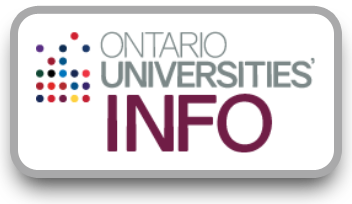Evolution of OUInfo
| Year | Event |
|---|---|
| 1970 |
Introduction of Counsellor Guidelines, a newsletter that provides a central, non-partisan compilation of Ontario university entrance requirements. |
| 1973 |
Counsellor Guidelines is renamed INFO and remains a resource for Ontario high school guidance counsellors. A different university volunteers each year to produce and distribute the magazine. |
| 1991 |
The Ontario Universities' Application Centre (OUAC) agrees to help produce and distribute INFO magazine at the request of the Council of Ontario Universities (COU) and the Ontario University Registrars' Association (OURA). |
| 1992 |
The OUAC implements a new policy to provide copies of the magazine to every graduating Ontario high school student. The INFO Editorial Board (IEB) is formed to guide the development of the magazine and determine its content. The IEB contains representatives from all parties served by INFO magazine, including the Ontario School Counsellors' Association (OSCA), the Ontario Universities' Council on Admissions (OUCA), the Standing Committee on Secondary School Liaison (SCSSL), COU, OURA and the OUAC. |
| 1999 |
The OUAC assumes full responsibility for producing INFO magazine, including coordinating and editing work that was previously done by university volunteers. While the IEB decides the INFO content and format, the OUAC compiles the information from Ontario universities and provides a unified editorial voice that highlights all Ontario universities equally. |
| 2002 |
OURA mandates that INFO magazine become electronic by 2008. In response, the IEB establishes a year-long commission to examine the migration from a printed magazine to an online version. The IEB indicates that an online INFO would be beneficial to:
|
| 2002 |
The eINFO (short for "electronic INFO") project plan is created to guide the development of the eINFO website. |
| 2002-2006 |
The IEB, through the OUAC, engages in extensive consultation with high school students and counsellors via surveys and focus groups to determine the needs for eINFO. |
| 2005 |
eINFO goes "live" in December. |
| 2006 |
The OUAC launches a new version of eINFO in September with additional search tools and updates. |
| 2007 |
In the fall, the OUAC completely redesigns eINFO in both appearance and function. It becomes a powerful resource that makes finding and comparing university information easier and faster. Users can:
|
| 2013 |
The IEB decides eINFO should be redesigned to address evolving design and accessibility standards. The IEB and the OUAC conduct surveys about the content and usability of the website with guidance counsellors, students and universities. |
| 2014 |
The new website launches in August and includes:
|
| 2019 |
eINFO is renamed Ontario Universities' Info (OUInfo) to better align with COU's new branding and the Ontario university community, and to more closely reflect the content of the website. The OUAC launches OUInfo in August. It includes a refreshed look and new logo while maintaining the same functionality. The IEB is renamed the Ontario Universities' Info Editorial Board (OUI-EB). |
| 2023 |
OUInfo adds sections for Resources for Indigenous Applicants, Extenuating Circumstances, Transitional Resources, and Equity, Diversity and Inclusion. |
The Future of OUInfo
From a counsellor's newsletter to a student's online database, INFO has evolved over the last 50 years and has the potential to develop even further. As university programs and the needs of students, parents and counsellors change, OUInfo adapts to better serve the needs of its users.
The OUInfo-EB continues to engage in surveys and focus groups to improve the function and design of OUInfo and include the information that is most valuable to its users.
